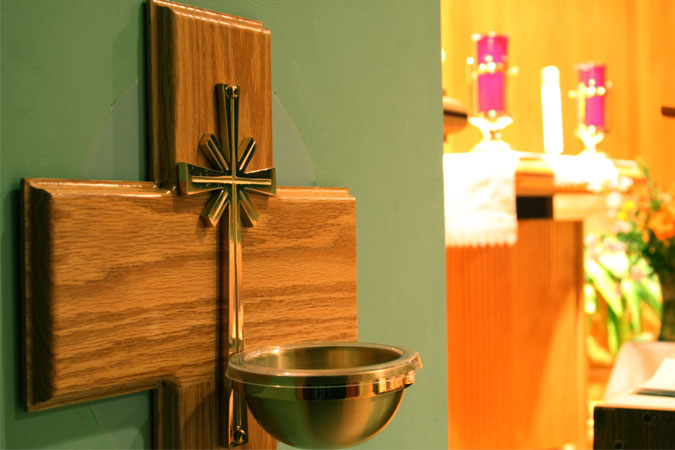
Mystagogy is a time for the community and the newly baptized to “grow in deepening their grasp of the paschal mystery and in making it part of their lives through meditation on the Gospel, sharing in the eucharist and doing the works of charity.” (RCIA 244) Mystagogy is clearly a period of encounter, accompaniment, and integration. Both the community and the newly initiated grow together.
Unlike adults who are instructed and mentored prior to Baptism, the process is reversed for those baptized as infants. After a child is baptized, the family and community accompany and mentor them into mature discipleship. So how do we transform classroom catechesis into a mystagogical experience? By making it the norm for children and families to celebrate, remember, and appreciate the sacramental mysteries in which they participate. Because children are very much in touch with what they experience through their senses, it’s easy to begin early.
Baptism
Place a bowl of water on the prayer table in your classroom as a reminder of Baptism, and use it in prayer and ritual. For example, offer a simple blessing at the end of class, inviting children to bless themselves with the water as they depart. (If parents are present, invite them to bless themselves and their children.)
Encourage families to commemorate anniversaries of Baptism. The date of each child’s Baptism could be provided to catechists, and the catechist can celebrate the anniversary in class or send a card home on behalf of the parish.
Remind children of their baptismal call. Start early with simple concepts, such as, “Baptism calls us to love one another,” or, “Baptism makes us part of God’s family.” As children grow, they can be guided to reflect on how Baptism calls them to worship, serve others, and work for justice.
Reconciliation
Make a point to reflect on Reconciliation, especially during Advent and Lent. Have children recall and share their feelings before and after the sacrament.
Eucharist
After children receive First Holy Communion, help them savor the ongoing experience of the Eucharist by referring often to what we do at Mass. A good practice could be to take one action or part of the Mass and review it each week. Ask children to journal, draw, perform, or discuss with others about what they remember. Have them pay attention to what they saw, heard, smelled, tasted, or touched. Ask them where they find Jesus at Mass or how they take Jesus in the Eucharist out into daily life. This kind of liturgical catechesis should continue well beyond second grade. Indeed, it should be lifelong!
Confirmation
While it may be difficult to get young people to return to catechetical sessions after Confirmation, make every effort to gather at least once for guided prayer and reflection on the experience of being confirmed, and to remind the young people how the Sacrament of Confirmation completes their Baptism.
Celebrating, remembering, and appreciating the sacramental mysteries will contribute to a parish culture of mystagogy and make intentional, communal reflection a normal way of life.
Confirmed in the Spirit is a fully bilingual, comprehensive, and flexible sacramental preparation program designed to welcome and form young people as they grow in faith and embrace their roles as disciples of Jesus Christ.




Reconciliation and Communion keeps us close to Jesus. Forgiving and loving everyone is one of Gods golden rule. Love the Lord thy God with your whole heart and soul and love your neighbors as yourself.